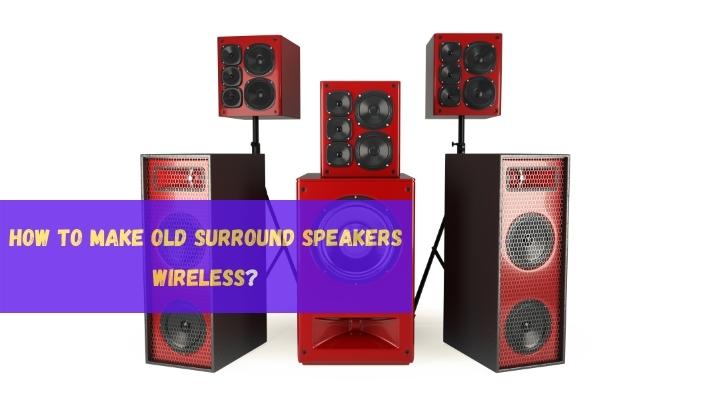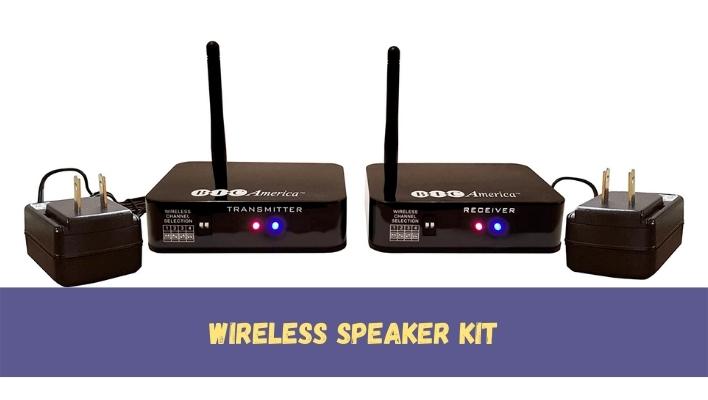We all love our music, and we want to be able to enjoy it in any room of our house. But sometimes, wired speakers can be a pain to deal with. If you have an old pair of speakers sitting around for a while, it might be time to get them out of your living room and into the garage. However, if you’ve never done this before, knowing which speaker cables work with which speaker types cannot be very clear.
In this article, we’ll explain how wireless speakers work so that it’ll be easier for everyone involved when you get started on your project (or if you already know what’s going on)!
What’s The Difference Between Wired & Wireless Speakers and How Do They Work?
Wired and wireless speakers work differently, despite depicting sound. While wired speakers use an audio cable to connect to a receiver or amplifier, wireless speakers use Bluetooth or Wi-Fi to connect to various devices.
Wireless speakers are not connected to the sound source; they connect via Bluetooth, Wi-Fi, and other wireless technologies. You can place them anywhere in your room, and they will still work. If you want more than one speaker, you can use a central hub that handles all of this automatically and allows multiple users access.
If you want to add extra speakers around your house, there are plenty of options, including
- A home stereo system with built-in amplifiers
- Connecting directly to an amplifier using cables

Why Make Your Speakers Wireless
Wireless surround sound speakers are becoming increasingly popular, and for a good reason. There are several advantages to using wireless surround sound speakers over traditional wired speakers.
- With traditional wired speakers, you’re limited by the length of the speaker cables, while wireless speakers allow you to place it anywhere in the room without worrying about tangled cords or running wires through walls.
- Wireless speakers can easily be set up over wired ones.
- Wireless speakers can be used in more places, like a concert hall or your backyard, where you might not be able to use a cable connection for fear of tripping on it (or, worse, pulling the power cord out).
- A wireless connection is also helpful if you have multiple rooms in your house and want everyone listening at once—you won’t have to worry about running cables across the floor!
- Finally, wireless surround sound systems are more reliable than wired. Because there are no wires to connect or disconnect, there’s less chance of something going wrong. And if one speaker fails, it shouldn’t affect the rest of the system.
How Can You Make Any speaker Wireless?
Wireless surround sound is growing in popularity as it provides a tidy and clutter-free method to enjoy your home theater. However, is it feasible to use an old set of speakers wirelessly?
Yes, practically any speaker can be made wireless to give you a quick answer. There are several distinct approaches to doing this, each with a unique mix of benefits and drawbacks. To help you choose which approach is best for you, we’ll review two of the most widely used ones.
Bluetooth:
Adding a Bluetooth receiver is one of the simplest ways to turn your old wireless speakers. This tiny gadget connects to the speaker and enables wireless Bluetooth connectivity to any Bluetooth-enabled gadget, including your smartphone or tablet.
Most Bluetooth receivers will function with any speaker; however, there are a few considerations. The receiver must first be strong enough to run your specific speakers. Second, ensure the receiver includes an AC converter so it can plug into an outlet if your speaker isn’t battery-operated. Last but not least, some receivers can only connect to one device at a time, so if you intend to use numerous devices (for instance, different cell phones), opt for a receiver that can.
Wi-Fi:
Adding a Wi-Fi receiver is another technique to make your old speakers wireless—this kind of receiver functions like a Bluetooth device. Your outdated speakers can be made wireless by using a Wi-Fi receiver. Similar to Bluetooth devices, it functions. The main distinction is that a wire will extend from it to your speakers. These Wi-Fi receivers come in various designs, but the computerized models with USB-b USB-c plugs are the most widely used ones.
Making your outdated surround sound speakers wireless is a fantastic way to maximize your audio without worrying about unsightly connections. Before making the transfer, there are a few things you should consider.
- First, examine if your speakers are already equipped with wireless connectivity. You might not even need to install anything because Bluetooth or Wi-Fi capabilities are incorporated into many more recent devices.
- You will need to purchase an extra receiver that can connect to your speakers if they aren’t wirelessly capable. To run the required cables, it will typically be necessary to drill a hole in the speaker cabinet.
What Is A Wireless Speaker Kit?
A wireless speaker kit is a set of speakers and a transmitter that you can connect to your audio source (such as an MP3 player) or another device, such as a stereo receiver or TV. The transmitters are connected to the audio source, while the speakers are connected directly.
You’ll need two things: A transmitter, which is also known as a “transmitter” or “receiver,” depending on how you use it, and at least two sets of speakers (or more).

How to Choose the Best Wireless Speaker Kit?
There are many wireless speaker kits available in the market today. The best way to choose the right one for your needs is by considering these factors:
- Whether or not you want an elegant, modern look and feel. Wireless speaker kits come in many color schemes and styles, so you can choose something that fits your home decorating style.
- How much money do you have? Most wireless speaker kits start at around $100. Still, if this isn’t enough for what you want, it might be worth investing more in higher quality products like Bose SoundStation or other brands with better sound quality (but fewer features).
How Can I Make My Speakers Wireless?
To make your old surround speakers wireless, you will need the following;
- A set of wireless speaker kits includes Bluetooth, Wi-Fi, and an auxiliary cable. The kit will allow you to stream music from your smart device or laptop wirelessly. It also comes with an auxiliary input that will enable you to connect other devices, such as an MP3 player or home theater speakers, without using an additional wire.
- Wireless subwoofer: A subwoofer that connects directly to your existing wiring behind the wall, allowing you to add bass without cutting any wires!
How to do it;
- Connect each speaker to a wireless receiver using a short piece of speaker wire with the insulation stripped at both ends. The red speaker wire connects to the right-hand terminal on the speaker and receiver by lifting the red plastic spring clip to expose a hole underneath to insert the wire. The other speaker wire connects to the left or black terminal similarly.
- Insert the plug into the electrical outlet on each receiver and plug the cord into a wall outlet.
- Connect the transmitter to an amplifier or receiver by attaching short pieces of speaker wire to the terminals on the transmitter and the corresponding terminals on the amplifier or receiver. For example, the terminals on the transmitter for the left audio channel should be connected with a short piece of speaker wire to the left channel terminals on the amplifier or receiver.
- Connect the power cable to the transmitter and a wall socket.
- Turn on the equipment and adjust the volume to the desired level.
Can I Make My Subwoofer Wireless Too?
You can make your subwoofer wireless too! It’s not hard to do. An A/V signal sender can be a valuable tool in helping you get the subwoofer in the area you want. An A/V signal sender sends audio over a 2.4 GHz radio signal between a transmitter and a receiver. You can get great sound from your wireless subwoofer with the right cables. Here’s how to go about it;
- Place the subwoofer where you want it to be placed and plug it into an outlet.
- Connect the RCA end of the RCA subwoofer to the RCA cable on the female end of the Y adapter.
- Match the red and white male ends of the Y adapter to the red and white ports on the A/V Signal Sender Receiver—the signal sender is a set (a receiver and a transmitter).
- Raise the antenna on the receiver. Install the batteries in the receiver and turn on the power. Plug the “subwoofer” end of the “subwoofer to RCA cable” into the line in port on the back of the subwoofer.
- Connect the red and white heads of the second Y adapter to the corresponding ports of the A/V transmitter signal sender. Raise the transmitter antenna, install the batteries and turn on the power.
- Plug the RCA end of the “Subwoofer to RCA” cable into the female end of the Y adapter and plug the “Subwoofer” end of the cable into the port on the back of your receiver labeled “Subwoofer.”
You can use them in your home theater or as part of an upgrade, like adding wireless headphones or earbuds so that everyone can enjoy music together.
Conclusion
We hope this article has helped you understand the basics of wireless speakers. If you want to make your old surround speakers wireless, then a wireless speaker kit is the best option. You can also use these kits to connect multiple speakers so that they can play as one large unit without interference from each other!
